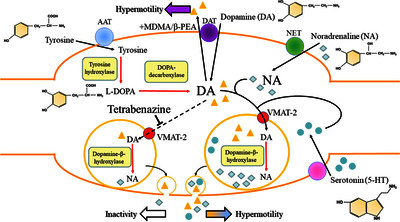Tod, Pál and Varga, Anita and Román, Viktor and Lendvai, Balázs and Pálkovács, Roland and Sperlágh, Beáta and Vizi, E. Szilveszter (2024) Tetrabenazine, a vesicular monoamine transporter 2 inhibitor, inhibits vesicular storage capacity and release of monoamine transmitters in mouse brain tissue. BRITISH JOURNAL OF PHARMACOLOGY, 1. ISSN 0007-1188
|
Text
BritishJPharmacology-2024-Tod-Tetrabenazineavesicularmonoaminetransporter2inhibitorinhibitsvesicular.pdf - Published Version Available under License Creative Commons Attribution Non-commercial. Download (3MB) | Preview |
|
![[img]](https://real.mtak.hu/205794/7.hassmallThumbnailVersion/gr.a.2.jpg)
|
Text (graphical abstract)
gr.a.2.jpg - Other Available under License Creative Commons Attribution Non-commercial. Download (183kB) | Preview |
Abstract
Background and Purpose Tetrabenazine (TBZ), used for treating hyperkinetic disorders, inhibits vesicular monoamine transporter-2 (VMAT-2), which sequesters monoamines into vesicles for exocytosis. However, our knowledge of the effect of TBZ on monoaminergic transmission is limited. Herein, we provide neurochemical evidence regarding the effect of VMAT-2 inhibition on vesicular neurotransmitter release from the prefrontal cortex (PFC) and striatum (STR) (brain regions involved in characteristic TBZ treatment side effects). The interaction between TBZ and MDMA was also assessed regarding motor behaviour in mice. Experimental Approach Vesicular storage capacity and release of [3H]-noradrenaline ([3H]-NA), [3H]-dopamine ([3H]-DA), [3H]-serotonin ([3H]-5-HT), and [3H]-acetylcholine ([3H]-ACh) was studied in mouse PFC and STR ex vivo slice preparations using electrical field stimulation. Additionally, locomotor activity was assessed in vehicle-treated mice and compared with that of MDMA, TBZ, and co-administered animals (n = 6) using the LABORAS system. Key Results TBZ lowered the storage capacity and inhibited the vesicular release of [3H]-NA and [3H]-DA from the PFC, and [3H]-DA and [3H]-5-HT from the STR in a concentration-dependent manner. Unlike vesamicol (vesicular ACh uptake inhibitor), TBZ failed to inhibit the vesicular release of [3H]-ACh from the PFC. When the vesicular storage of the investigated monoamines was inhibited by TBZ in the PFC and STR, MDMA induced the release of transmitters through transporter reversal; MDMA dose dependently increased locomotor activity in vivo. Conclusion and Implications Our observations provide neurochemical evidence explaining the mechanism of VMAT-2 inhibitors in the brain and support the involvement of dopaminergic and noradrenergic transmission in hyperkinetic movement disorders.
| Item Type: | Article |
|---|---|
| Uncontrolled Keywords: | acetylcholine, exocytosis, hyperkinesis, mouse model, tetrabenazine, vesicular monoamine, transport proteins |
| Subjects: | R Medicine / orvostudomány > R1 Medicine (General) / orvostudomány általában |
| SWORD Depositor: | MTMT SWORD |
| Depositing User: | MTMT SWORD |
| Date Deposited: | 25 Sep 2024 07:24 |
| Last Modified: | 25 Sep 2024 07:24 |
| URI: | https://real.mtak.hu/id/eprint/205794 |
Actions (login required)
 |
Edit Item |




